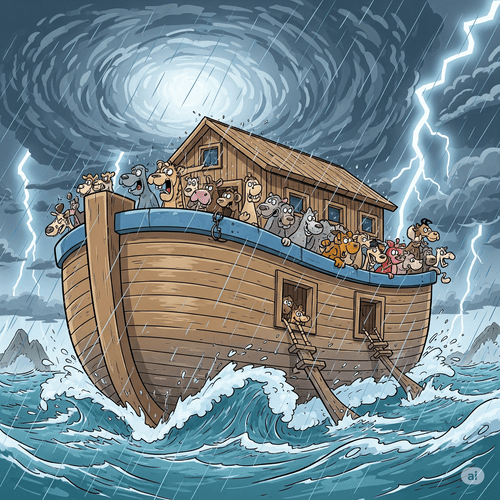Why Noah’s Flood Was Global: Scientific Evidences Often Overlooked
For decades, the debate has raged: Was Noah’s flood a local Middle Eastern event, or did it literally cover the entire Earth? While mainstream geology favours regional flood interpretations, a growing body of scientific evidence suggests we may have overlooked compelling data pointing to a global catastrophe.
Let’s examine the geological fingerprints that could rewrite our understanding of Earth’s history.
THE WORLDWIDE FOSSIL MYSTERY
Walk into any natural history museum, and you’ll see something remarkable: marine fossils embedded in rock formations thousands of feet above sea level. Seashells crown the Himalayas. Ocean creatures are fossilised in the American Midwest. Whale bones rest in desert mountains.
The standard explanation? These areas were once covered by ancient seas over millions of years. But there’s another pattern that’s harder to explain: the fossils often show signs of rapid, violent burial. Delicate features are preserved. Fish are fossilised mid-swim. Entire ecosystems appear flash-frozen in time.
Dr Steven Austin’s research at Mount St Helens demonstrated massive sedimentary layers—previously thought to require thousands of years—can form in hours under catastrophic conditions. What if similar processes operated on a global scale?
THE SEDIMENTARY LAYER PUZZLE
Perhaps the most striking evidence lies beneath our feet. Across every continent, we find massive sedimentary rock layers that stretch for hundreds of miles. The Tonto Group in the Grand Canyon extends across multiple states. Similar formations span continents.
These aren’t small, localised deposits. They’re continental-scale blankets of sediment that appear to have been laid down rapidly by moving water. The sheer volume of material moved defies explanation by normal river systems or regional floods.
Consider the Coconino Sandstone in Arizona—a layer containing billions of tonnes of sand with distinctive cross-bedding patterns. Experiments show these patterns form under high-velocity water flow, not wind as traditionally assumed. The scale suggests something far beyond local flooding.
THE GLOBAL FLOOD TRADITION
Here’s where geology meets anthropology. Over 270 cultures worldwide preserve flood traditions remarkably similar to the biblical account. From the Mesopotamian Epic of Gilgamesh to Native American legends, from Australian Aboriginal stories to Chinese historical records, the pattern is consistent: a global flood, a saved family, animals preserved, and a new beginning for humanity.
Critics argue these stories simply reflect common regional flooding. But the details are too specific and too widespread. Many of these cultures had no contact with each other, yet they share elements like birds sent out to find dry land, the landing on a mountain, and divine judgment as the cause.
THE LANGUAGE OF SCRIPTURE
The Hebrew text of Genesis uses specific language that suggests global scope. The word kol (all/every) appears repeatedly: “all the high hills under the whole heaven were covered.” This same word describes God’s covenant with “all flesh” and Noah taking “all food that is eaten.”
If Moses intended to describe a local flood, Hebrew had perfectly adequate terms. The Nile floods were described with different language entirely. The text strains to emphasise universality at every turn.
MODERN GEOLOGICAL DISCOVERIES
Recent discoveries have challenged uniformitarian assumptions about geological processes. The Channelled Scablands of Washington State, carved by catastrophic flooding when ice dams broke, demonstrated that massive landscape changes can happen rapidly. What was once thought impossible—carving deep canyons in days—is now documented fact.
Similarly, the discovery of soft tissue in dinosaur fossils has raised questions about deep time assumptions. If organic material can survive supposedly millions of years in dinosaur bones, what other geological assumptions need revisiting?
THE WATER QUESTION ANSWERED
“Where did all the water come from?” sceptics ask. Genesis describes two sources: “fountains of the great deep” and “windows of heaven.” Modern plate tectonics reveals massive water reservoirs beneath the Earth’s crust—more water than in all the oceans combined.
Recent studies suggest catastrophic plate movement could have released enormous volumes of superheated water from the mantle. Combined with atmospheric water vapour, this could provide the volume needed for the global flooding.
The water didn’t disappear—it redistributed. If the ocean basins deepened and the continents rose (both consistent with post-flood geological activity), the same water that once covered the Earth now fills deeper ocean basins.
THE ICE AGE CONNECTION
A global flood provides an elegant explanation for the Ice Age that followed. Massive volcanic activity associated with “the fountains of the great deep” would have filled the atmosphere with particulates, blocking solar radiation. Meanwhile, warm oceans would have provided the moisture for massive ice accumulation.
This explains why the Ice Age was relatively brief and why it ended—unlike the gradual climate changes proposed by conventional models.
ADDRESSING THE CHALLENGES
Critics raise valid questions about animal distribution, genetic diversity, and the logistics of the ark. But these objections often assume modern conditions applied to the ancient world. Post-flood land bridges during the Ice Age could explain animal migration. Rapid speciation from genetic bottlenecks is observable in nature. The ark’s dimensions, calculated precisely, could accommodate representatives of animal kinds rather than every modern species.
WHY NOAH’S FLOOD WAS GLOBAL: THE BIGGER PICTURE
The evidence points toward a catastrophic event that reshaped Earth’s surface, buried ecosystems rapidly, and left geological signatures we’re still discovering. This doesn’t require abandoning good science—it requires remaining open to evidence that challenges our assumptions.
Whether examining the fossil record, sedimentary layers, or cultural memories, the patterns suggest something more dramatic than regional flooding. The Earth bears the scars of a global catastrophe that transformed continents, buried ecosystems, and left survivors to rebuild civilisation.
Perhaps it’s time to take a fresh look at both the geological evidence and the historical account that has preserved this memory for millennia. The rocks may be telling us a story we’ve been too quick to dismiss.
WHY NOAH’S FLOOD WAS GLOBAL: RELATED FAQs
What do prominent young earth creation scientists say about the global flood? Leading creation scientists like Dr John Morris (Institute for Creation Research) and Dr Andrew Snelling (Answers in Genesis) argue the geological column itself is evidence of flood sequence, with marine creatures buried first in lower layers and terrestrial animals in upper layers. They point to the absence of soil layers between rock formations as evidence these weren’t deposited over millions of years. Dr Kurt Wise, a Harvard-trained palaeontologist, emphasises the fossil record shows ecological zones being buried in sequence—exactly what we’d expect from rising floodwaters.
- How could Noah’s family repopulate the entire Earth genetically? Population geneticists within the creation science community, like Dr Nathaniel Jeanson, argue the human genome contains sufficient genetic diversity within just eight people to account for all modern human variation. Recent studies show most human mitochondrial DNA lines trace back to a relatively recent common female ancestor (biblical “mitochondrial Eve”). The rapid population growth rates documented in historical times demonstrate that small founding populations can quickly diversify and spread across continents within centuries.
- What about the problem of freshwater vs. saltwater fish survival? Marine biologist Dr Frank Sherwin notes many fish species today can tolerate both fresh and saltwater environments, and laboratory studies show fish can adapt to salinity changes within generations. During a global flood, massive rainfall would have created varying salinity zones throughout the floodwaters. Additionally, many “freshwater” fish fossils are found in marine sediments, suggesting they could survive in mixed-salinity conditions. Post-flood speciation could have rapidly produced the specialized freshwater and saltwater species we see today.
How do creation scientists explain the ordering of fossils in rock layers? Dr Steven Austin and other flood geologists propose fossil ordering reflects ecological burial sequence rather than evolutionary progression. Marine creatures living on ocean floors would be buried first, followed by shallow-water organisms, then terrestrial plants and animals as floodwaters rose. The apparent “progression” from simple to complex actually reflects habitat zones from deep ocean to high elevations. They also point out many “index fossils” are found out of sequence, contradicting the standard geological timeline.
- What about radiometric dating showing rocks are millions of years old? Creation physicist Dr Russell Humphreys and others argue radiometric dating assumes constant decay rates, but catastrophic conditions during the flood could have accelerated nuclear decay. The Radioisotopes and the Age of the Earth (RATE) project found evidence of accelerated decay in zircon crystals and helium retention rates that suggest much younger ages. They propose the intense heat and pressure during flood tectonics created conditions that dramatically sped up radioactive processes, making rocks appear much older than they actually are.
- How do flood geologists explain coal and oil formation? Creation geologist Dr Andrew Snelling argues coal and oil formation doesn’t require millions of years but massive burial of organic material under specific pressure and temperature conditions. Laboratory experiments have produced coal from plant material in weeks under the right conditions. The global flood would have buried enormous quantities of pre-flood vegetation and marine organisms simultaneously, creating ideal conditions for rapid coal and oil formation. This explains why coal seams often contain marine fossils and why oil deposits are found in patterns consistent with catastrophic burial.
What evidence do creation scientists cite for rapid canyon formation? Flood geologists point to examples like the rapid carving of Burlingame Canyon in Washington (carved in six days during a 1926 flood) and Providence Canyon in Georgia (formed by erosion in just 150 years). Dr Steve Austin’s research at Mount St. Helens showed that a relatively small mudflow carved a 140-foot-deep canyon in a single day. They argue that the Grand Canyon’s layers show evidence of rapid water flow and that the Colorado River couldn’t have carved uphill through the Kaibab Plateau. Instead, they propose the canyon formed rapidly as floodwaters drained off the continent, carving through still-soft sedimentary layers.
WHY NOAH’S FLOOD WAS GLOBAL: OUR RELATED POSTS
- Rocks Don’t Lie: 10 Global Evidences Supporting Noah’s Flood
- Ancient Flood Stories Compared: What Makes Noah’s Account Different?
- Fact Vs. Fiction: Did Rain Exist Before Noah’s Time?
- After the Flood: Did Noah Release a Raven Or A Dove?
- Why Didn’t Jesus Come Before Noah’s Flood? God’s Perfect Timing…
- What Specifically Was the Sin of Ham, Noah’s Son?
Editor's Pick

The Throne-Room Vision: Who Did Isaiah See?
The scene is unforgettable: Isaiah stands in the temple, and suddenly the veil between heaven and earth tears open. He [...]

The Angel of the Lord: Can We Be Certain It Was Christ All Along?
Throughout the Old Testament, a mysterious figure appears: the Angel of the LORD. He speaks as God, bears God’s name, [...]
SUPPORT US:
Feel the Holy Spirit's gentle nudge to partner with us?
Donate Online:
Account Name: TRUTHS TO DIE FOR FOUNDATION
Account Number: 10243565459
Bank IFSC: IDFB0043391
Bank Name: IDFC FIRST BANK






